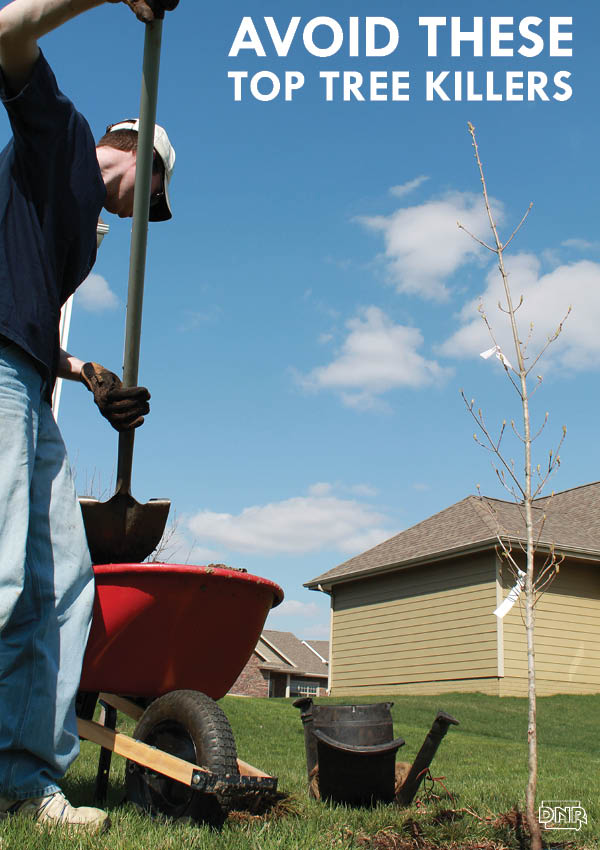 Trees add beauty, increase property value, clean the air, provide shade and create habitat. Get the most from your leafy wonders with these simple steps to ensure your trees avert an early demise.
Trees add beauty, increase property value, clean the air, provide shade and create habitat. Get the most from your leafy wonders with these simple steps to ensure your trees avert an early demise.
Mower Blight Bumping a young tree with a mower, hitting it with a weed trimmer or tying a dog chain to the trunk takes a toll. “There is living tissue right under the bark,” says DNR forester Matt Brewer. Bumps and nicks create a compartmentalized wound unable to carry water and nutrients and leads to decay. Prevent damage by extending mulched areas farther from the trunk into the drip line—the area where water drips off the farthest leaf. Doing so keeps mowers at bay. “Don’t value your lawn more than your trees,” says DNR forester Laura Wagner.
Watering Issues New trees often don’t get enough water. “People water after planting, then forget the tree for a month,” says Brewer. How much water is enough? First, lawn sprinklers and irrigators are not adequate for trees—the superficial watering leads to shallow roots. Older advice called for watering 20 minutes a week using a slow hose drip— about 10 gallons. New recommendations from Iowa State University up the frequency. For new trees, water once to three times weekly directly above the root ball. Use 2 gallons for every inch of trunk diameter (measured 6 inches off the ground). Use a 5-gallon bucket with a small hole in the bottom. During wet years, be careful as keeping a root ball saturated can cause root decay.
Planting Too Deep More than half the residential trees in the nation are planted too deep, say Wagner. This includes trees planted by nursery staff and landscapers. Planting too deep causes early mortality—for example, a tree may survive 25 years, but not reach its 100-plus-year natural lifespan. If set too deep, trunks grow new, weak roots off the stem which can encircle and choke and promote rot and decay. It also creates a weak spot—susceptible to wind throw—where the trunk breaks above ground in high wind. When planting, ensure the natural taper or root flare at the base of the trunk is slightly above ground.
Roots That Choke As roots grow in diameter, any circling roots will act like a noose—cutting off water, nutrients and encouraging rot and decay. A tree with circling roots is weak and more susceptible to falling in high winds. Before planting, examine the root ball and prune or straighten any encircling roots.
Pruning Issues Every cut to a tree is an injury—so prune with purpose. Trees need branches and leaves to store and produce food, so only remove what really must go. Cut to the branch collar, not flush to the limb or trunk to encourage proper scar tissue formation. For branches greater than 1-inch diameter, use the three-cut method. Don’t prune a tree the first two years after planting.
Tree Topping Removing tree tops is harmful, expensive, promotes sucker growth and makes a tree potentially hazardous. People choose to top a tree believing the tree is too large and they remove a large percentage of branches and limbs. Any company that proposes tree topping should be avoided.
Tree Selection Plant the right site with the right species with a healthy tree. Ensure the species you select will not be too large for the site. Take into account overhead obstructions such as power lines and hard surfaces such as roads, sidewalks and driveways that prevent roots from obtaining moisture and oxygen. Envision the tree at maturity and the proximity to homes. Consider its sunlight needs, shade tolerance, growth rate and other factors.
Soil Changes Adding decorative retaining walls or deep flower beds around trees can cause harm. Changes to grade such as adding or removing soil can impact trees years later. That seemingly invincible mature bur oak will die quickly after a grade change. Since trees don’t like changes, avoid or minimize landscape alterations. Construction activity is particularly hard on trees. Minimize digging to lessen cutting and tearing of roots. Heavy equipment traffic under drip lines should be avoided to prevent soil compaction.
Volcano Mulching Piling a thick cone of mulch up against a trunk is a top tree-killing practice, says DNR urban forester Emma Hanigan. Doing so keeps the trunk overly moist—leading to rot and decay. Dodge this tree destroyer by keeping mulch away from the trunk. Think “donut shape” with a mulch-free area a few inches from the trunk. Extend mulch far from the trunk to maintain moisture, prevent weeds and regulate ground temperature over more area. Use a 3-inch deep layer of wood chips. Don’t mulch with grass clippings—they compress and mat together to restrict water and oxygen availability—mix grass in with the compost pile instead.
Ties that Bind Objects such as stakes, tags, wire and rope cause harm if not removed. Most healthy trees do not require staking if they have a good root ball. Larger bare root trees do require staking.
RESOURCES TO LEARN MORE - DNR online videos explain tree selection, planting depth and mulching. Youtube.com/iowadnr - Check out our In Your Own Backyard board on Pinterest.
This article originally appeared in the May/June 2013 issue of Iowa Outdoors magazine.